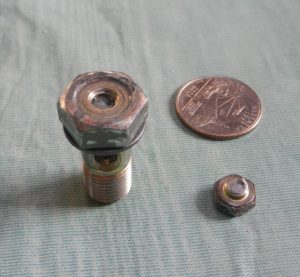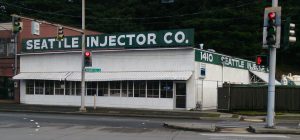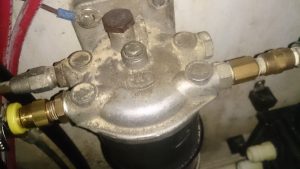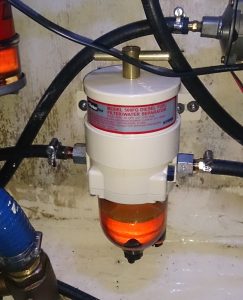Or simple pleasures…
A little more than two years ago, I started having trouble getting the engine to start if it sat more than three days.
To remedy the problem, I made sure I started it more often than than that. When went our three week trip up the west side of Vancouver Island that year, it was never a problem: we never went that long without starting the engine.
But as time passed, the interval became shorter and shorter until 90 minutes, then less than an hour. It wasn’t until quite a distance into last year’s five-month Alaskan adventure that we figured out it was air in the fuel line collecting below the injector pump. After that starting the engine became a two-step process: Bleed the engine, press the starter button. It was a reliable process and that is all that really matters.
 Bleeding the engine culminated in shearing off the bleed screw in Quigley Cove.
Bleeding the engine culminated in shearing off the bleed screw in Quigley Cove.
Because we knew this was the process, there was never any trouble moving from sail to power. We would just bleed and start the engine before dousing the sails – we always started the engine before dousing sails.
Advice came from everyone, from people without a clue to experienced diesel mechanics. The only thing that we never did was pressurize the fuel lines to see if we would see fuel leaking out. We should have – I don’t know whether it would have shown the leak or not, but we should have tried.
I replaced everything that could be replaced all the way back to the tank, except the filter.
 What was amazing was all the things it wasn’t.
What was amazing was all the things it wasn’t.
One person, Rick, at Seattle Injectors suggested the filter.
The installed fuel filter is an English product visible in every story in the British Magazine, Yachting Monthly, that has anything to do with engines. To our American eyes it is a typically British product. The arrows on the filter don’t point in the direction of fuel flow, they point in the direction the fuel is coming from.
 There is no way to ease the priming by pouring fuel into the the filter, the air needs to be drawn out by a pump. To change the filter cartridge, the filter must be disassembled with a catch bucket underneath.
There is no way to ease the priming by pouring fuel into the the filter, the air needs to be drawn out by a pump. To change the filter cartridge, the filter must be disassembled with a catch bucket underneath.
 Last week I cut the current filter out of the fuel circuit and spliced in a new Racor. Now my Racor is a Racor. Attached to the old filter are the two diesel cabin heaters on the boat. Is the air leaking in from the heater connections rather than the filter? I don’t know.
Last week I cut the current filter out of the fuel circuit and spliced in a new Racor. Now my Racor is a Racor. Attached to the old filter are the two diesel cabin heaters on the boat. Is the air leaking in from the heater connections rather than the filter? I don’t know.
The engine has started easily, without bleeding, three times across two successive days. I’m feeling optimistic. The next step is to plumb the diesel heaters into the circuit. The current plan to plumb them into a ‘‘T’’ before the new Racor behind a check valve so that no fuel or air can flow backwards into the new Racor.
I’ll keep you posted.
8-May-2017 The problem is that we still have air in the fuel line. Nothing has changed. I’ll try to attach a pump to pressurize the line and see if we can find something that way.

